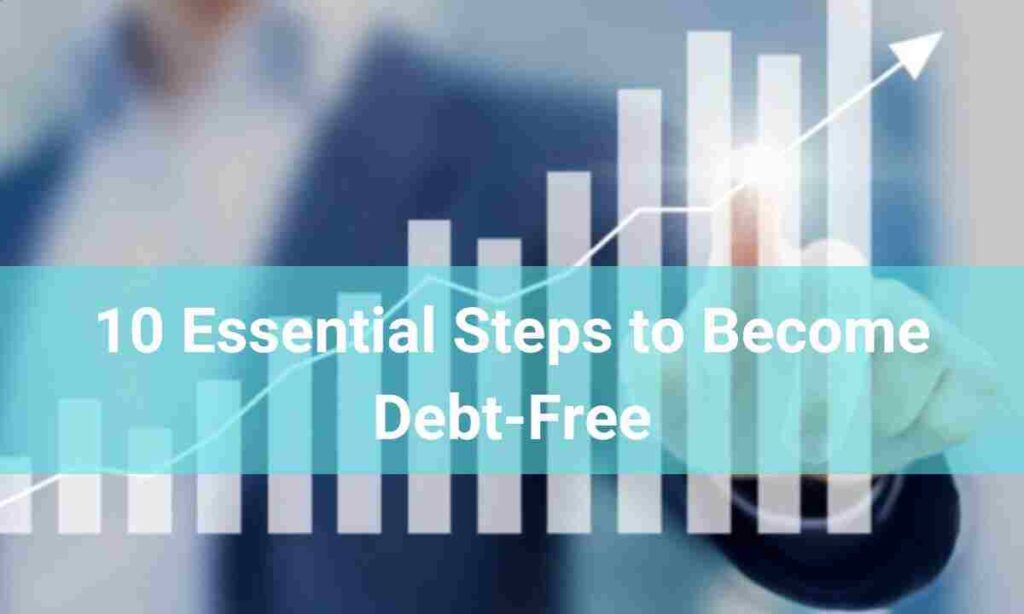
Debt can feel overwhelming, but with discipline, planning, and commitment, it’s possible to break free from financial burdens and achieve lasting financial independence. Becoming debt-free is not just about paying off what you owe—it’s about changing your financial habits, managing your money wisely, and setting yourself up for future success. Here are 10 essential steps you must take to become debt-free.
1. Create a Detailed Budget
The first step toward becoming debt-free is to gain full control of your finances by creating a detailed budget. This budget should account for all your income, expenses, and debts. By tracking every dollar, you’ll be able to see where your money is going and where you can cut back to allocate more toward debt repayment.
Tip: Use budgeting apps or spreadsheets to keep track of your income and expenses consistently.
2. List All Your Debts
Make a list of all your debts, including credit card balances, student loans, personal loans, car payments, and mortgages. Write down the total amount owed, the interest rates, and the minimum monthly payments. This list will help you understand the full scope of your debt and prioritize which debts to tackle first.
Tip: Keep this list visible as a reminder of your goals and progress.
3. Prioritize High-Interest Debt
High-interest debts, like credit card debt, can accumulate quickly and become a major financial burden. To make the most progress, prioritize paying off debts with the highest interest rates first. This method, known as the “avalanche method,” helps you reduce the total interest paid over time.
Tip: Continue making minimum payments on other debts while focusing extra payments on the highest-interest debt.
4. Use the Snowball Method for Motivation
If the avalanche method feels too overwhelming, the “snowball method” might be a better fit for you. In this strategy, you pay off the smallest debt first and then move on to the next smallest. This gives you quick wins and helps build momentum and motivation.
Tip: Celebrate small victories as you pay off each debt—this can keep you motivated throughout the process.
5. Cut Unnecessary Expenses
Review your budget and identify any unnecessary expenses or luxuries you can temporarily cut back on. This may include dining out, entertainment subscriptions, or impulse purchases. Redirecting these funds toward debt repayment can speed up the process significantly.
Tip: Consider adopting a minimalist lifestyle while you work on paying off your debts. It’s temporary but effective.
6. Increase Your Income
One of the fastest ways to pay off debt is by increasing your income. Consider taking on a side hustle, freelancing, selling unused items, or even asking for a raise at your current job. Use any additional income to make extra payments on your debt.
Tip: Avoid lifestyle inflation—don’t increase your spending as your income rises. Instead, put that extra money toward debt.
7. Establish an Emergency Fund
It may seem counterintuitive to save while paying off debt, but an emergency fund prevents you from falling deeper into debt when unexpected expenses arise. Start with a small emergency fund of $500 to $1,000 to cover minor emergencies and prevent the need for credit cards.
Tip: Keep your emergency fund in a separate savings account to avoid spending it on non-emergencies.
8. Consolidate or Refinance Your Debts
If you have multiple debts with high-interest rates, consider debt consolidation or refinancing. This allows you to combine all your debts into a single loan with a lower interest rate, simplifying your payments and potentially reducing the amount of interest you’ll pay over time.
Tip: Look for consolidation options with no or low fees to maximize savings.
9. Avoid Taking on New Debt
To become debt-free, you must stop accumulating new debt. Avoid using credit cards or taking out new loans unless absolutely necessary. Focus on living within your means and paying with cash or debit instead of relying on credit.
Tip: Consider temporarily freezing your credit cards or reducing your credit limit to curb the temptation to spend.
10. Stay Consistent and Patient
Becoming debt-free takes time and consistency. It’s essential to stay committed to your budget, avoid unnecessary spending, and continue making extra payments whenever possible. Progress may feel slow at times, but persistence will pay off in the long run.
Tip: Regularly track your progress and remind yourself of the financial freedom you’re working toward. Set milestones and reward yourself (without spending excessively) for each goal you achieve.
Conclusion
Becoming debt-free is a gradual process that requires careful planning, discipline, and a commitment to changing financial habits. By creating a budget, prioritizing debt payments, cutting back on expenses, and increasing your income, you can accelerate your path to financial freedom. While the journey may be challenging, the long-term rewards of financial independence and peace of mind are well worth the effort.
With the right mindset and strategies, you can successfully eliminate debt and secure a brighter financial future.
